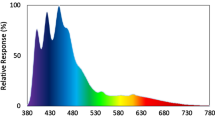Abstract
The small neritic cephalopod Euprymna scolopes possesses a large glandular light organ that contains the symbiotic luminous bacterium Vibrio fischeri. Adult and immature E. scolopes were caught in the evening with dip nets in shallow water along the shore of Kanohe Bay, Oahu, Hawaii, during late February 1984. The initiation of the symbiosis was investigated by rearing the cephalopods either in seawater taken from aquaria containing adult E. scolopes or in seawater with reduced bacterial concentrations due to filtration or due to absence of adults. Light production was measured during early development. Bioluminescence was not detected in E. scolopes immediately after hatching. Most individulas of E. scolopes that hatched into seawater containing, or previously exposed to, adults produced light within 24 h. Individuals that hatched into filtered seawater did not produce light. The data suggest that each generation aquires an infection from free-living bacteria rather than from the egg, and that light production is dependent on the nutritional state of the host. Access to an initial inoculum of free-living, luminous bacteria seems to be critical for establishing a successful symbiosis.
Similar content being viewed by others
Literature cited
Arnold, J. M., Singley, C. T., Williams-Arnold, L. D. (1972). Embryonic development and post-hatching survival of sepiolid squid Euprymna scolopes under laboratory conditions. Veliger 14: 361–364
Harvey, E. N., (1952). Bioluminescence. Academic Press, New York
Hastings, J. W., Nealson, K. H. (1981). The symbiotic luminou bacteria. In: Starr, M. P., Stolp, H., Truper, H. G., Balows, A., Schlegel, H. G. (eds.) The prokaryotes. Springer Verlag, New York, Heidelberg, Berlin, p. 1332–1345
Herring, P. J. (1977). Bioluminescence of marine organisms. Nature, Lond. 267: 788–793
Herring, P. J. (1988). Luminescent organs. In: Trueman, E. R., Clarke, M. R. (eds.). The Mollusca. Vol. II. Form and function. Academic Press, Inc. San Diego, p. 449–489
Herring, P. J., Clarke, J. R., Boletsky, S. V., Ryan, K. P. (1981). The light organs of Sepiola atlantica and Spirula spirula (Mollusca: Cephalopoda): bacterial and intrinsic systems in the order Sepioidea. J. mar. biol. Ass. U.K. 61: 901–916
Meyer-Rochow, V. B. (1976). Loss of bioluminescence in Anomalops katoptron due to starvation. Experientia 32: 1175–1176
Morin, J. G. (1983). Coastal bioluminescence: patterns and functions. Bull. mar. Sci. 33: 787–817
Nealson, K. H. (1977). Autoinduction of bacterial luciferase. Occurrence, mechanism and significance. Archs Microbiol. 112: 73–79
Orndorff, S. A., Colwell, R. R. (1980). Distribution and identification of luminous bacteria from the Sargasso Sea. Appl. envirl Microbiol. 39: 983–987
Reichelt, J. L., Nealson, K. H., Hastings, J. W. (1977). The specificity of symbiosis: pony fish and luminescent bacteria. Archs Microbiol. 112: 157–161
Ruby, E. G., Greenberg, E. P., Hastings, J. W. (1980). Planktonic marine luminous bacteria: species distribution in the water column. Appl. envirl Microbiol. 39: 302–306
Ruby, E. G., Nealson, K. H. (1976). Symbiotic association of Photobacterium fischeri with the marine luminous fish Monocentris japonica: model of symbiosis based on bacterial studies. Biol. Bull. mar. biol. Lab., Woods Hole 151: 574–586
Singley, C. T. (1980). Ultrastructure of the bacterial photophore of the sepiolid squid Euprymna scolopes. Abstracts of the 46th Annual Meeting of the American Malacological Union (AMU). AMU, Louisville, Kentucky, p. 20
Tebo, B. M., Linthicum, D. S., Nealson, K. H. (1979). Luminous bacteria and light emitting fish: ultrastructure of the symbiosis. Biosystems (Amsterdam). 11: 269–280
Author information
Authors and Affiliations
Additional information
Communicated by P. C. Schroeder, Pullman
Rights and permissions
About this article
Cite this article
Wei, S.L., Young, R.E. Development of symbiotic bacterial bioluminescence in a nearshore cephalopod, Euprymna scolopes . Mar. Biol. 103, 541–546 (1989). https://doi.org/10.1007/BF00399586
Accepted:
Issue Date:
DOI: https://doi.org/10.1007/BF00399586




